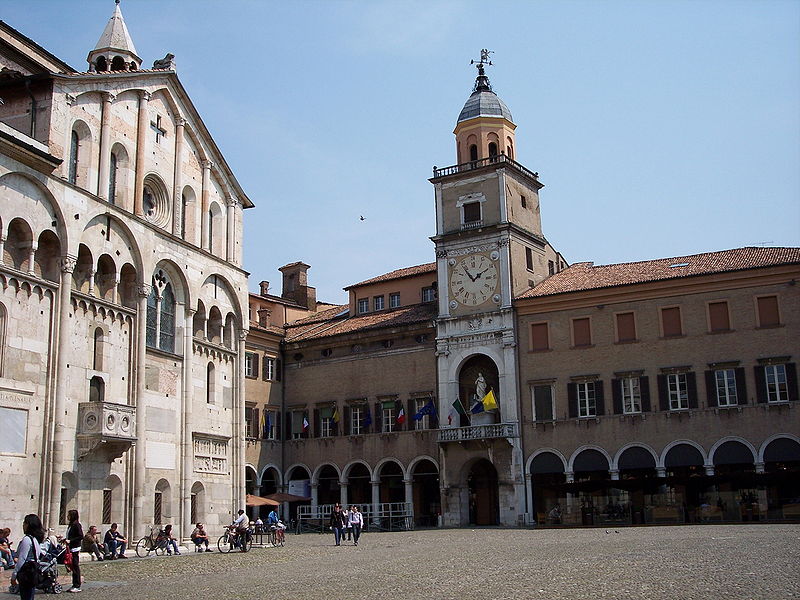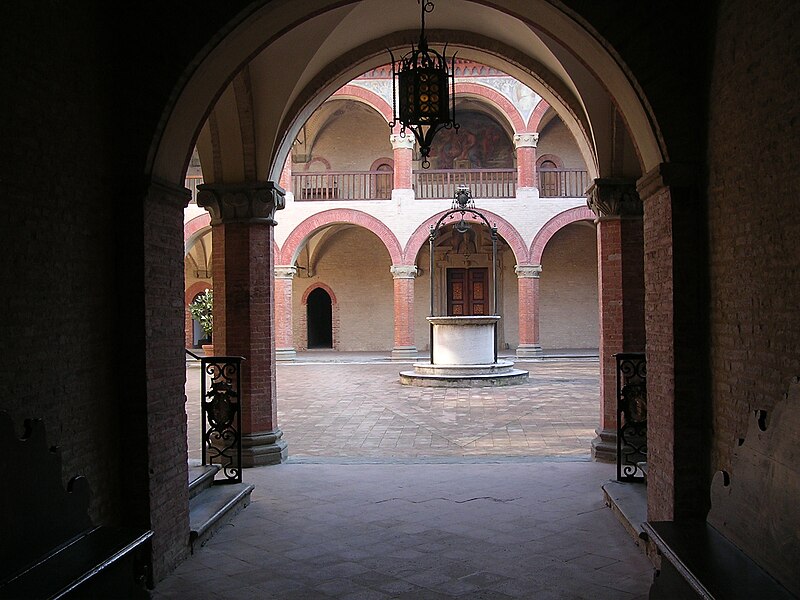All of Italy's ancient cities are full of historically important architecture and sites, and all have seen important events. Stage Four visits some that have more than most.
 |
| Cathedral and City Hall, Modena |
Several places are worth seeing along the way. Modena is perhaps most famous nowadays as the home of Ferrari, Lamborghini, Maserati, Pagani and De Tomaso and for balsamic vinegar, but it has more than its fair share of monuments and historical buildings. Among those not to be missed are the Cathedral, begun in the 11th Century, home to the relics of Saint Geminianus (a 4th Century bishop of Modena, who tradition has it saved the city from the Huns by the rather un-Christian technique of producing a magic fog) and one of the earliest known depictions of scenes from the legend of King Arthur; the Ducal Palace and the City Hall, cobbled together during the 17th and 18th Centuries from various buildings dating from as far back as the middle of the 11th Century and forming one harmonious whole.
 |
Collegio di Spagna, the oldest of the University' constituent
colleges |
Bologna - where locals often tell you they've never heard of spaghetti bolognese - has even more, with the San Petronio Basilica (the world's fifteenth largest church), the spindly, precariously leaning Two Towers and the Baroque Cathedral especially worthy of note. It is home to a university, founded in 1088 and considered to be the oldest continually-operating example in the world. Described at the point of its foundation as "universitas magistrorum et scholarium," it gave us the word
university. Once, Bologna had even more historical monuments; 44% of what once stood in the city was either completely destroyed or severely damaged during a single day of Alled bombing on the 16th of July, 1944. The city is sometimes known as
La Dotta ("the learned one") on account of the University and sometimes as
La Grassa ("the fat one") on account of its cuisine and prominent wealth.
 |
| Tiberius Bridge, Rimini |
Rimini, where the race reaches the Adriatic, has despite being one of Europe's most popular holiday destinations and home to more than a thousand hotels, bars and clubs retained a great deal of historical sites including the Tiberius Bridge, begun in 14CE and finished seven years later (the race doesn't cross it, unfortunately) and the Castel Sismondo which, when built in the 15th Century, was outside the city; the fact that all of its towers face the city centre reveal that Sigismondo Pandolfo Malatesta, the nobleman who commissioned it, was afraid of attacks by his own subjects rather than outside forces (and a brief look at his history reveals that he was not an especially pleasant character: historian Francesco Guicciardini called him the "enemy of every peace and well-living" and Pope Pius II - who was a considerably better man that certain other popes through the ages and, rather peculiarly in the eyes of modern observers such as us, wrote a very successful and bawdy obscene play called
Chrysis - accused him of "rape, adultery, and incest." Malatesta is also said to have rid himself of one unwanted wife by having a servant drown her, and the Duke of Urbino claimed that he committed incest with his own son).
 |
| Arco di Augusto, Fano |
The race ends in Fano, where traces of the defensive walls built by Julius Caesar can still be seen. Th town was presented as a gift to the Frankish Kings of Germany in 754 by the Pope, but was returned to papal control in the 15th Century by Federico III da Montefeltro who had taken it from our friend Malatesta (it was Federico, in fact, who accused Malatesta of incest. Federico is the man in the famous painting by Piero della Francesca, wearing a red hat and showing his peculiar nose: he had his nasal bridge surgically removed, which must have been an unimaginably painful operation in those pre-anaesthesia times, to widen his eyesight following the loss of his right eye in an accident so that he would be better able to spot would-be assassins - because his enlightened beliefs, which included making all citizens equal under the law no matter what their social status, earned him as many enemies as friends). Fano, like Bologna, was once home to numerous towers erected by noble families in an effort to out-do one another, but none of them survive - some were destroyed by time and neglect, others by Napoleon, more during heavy shelling by the Austro-Hungarian Navy in the First World War and then by Allied bombing in the Second;then the last by retreating Nazi troops.





No comments:
Post a Comment